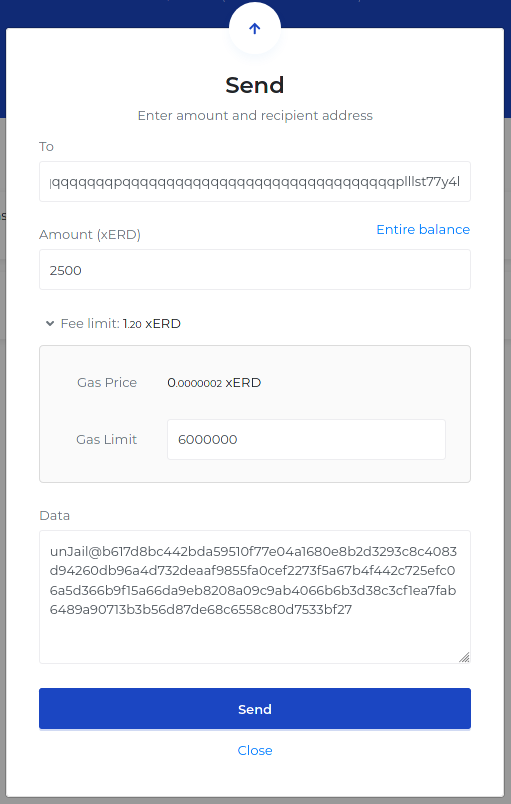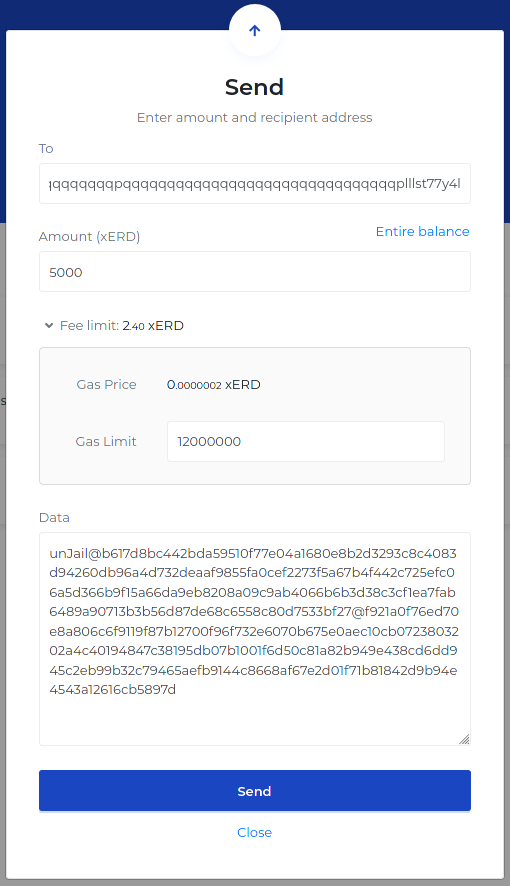Unjailing
In the unfortunate situation of losing too much rating score, a validator will be jailed, which means that they will be taken out of the shards, they will not participate in consensus, and thus they will not earn any more rewards. Currently, the rating limit at which a node will be jailed is 10. Read more on the Ratings page.
You can reinstate one of your jailed validators using an unjailing transaction. This transaction effectively represents the payment of a fine. After the transaction is successfully executed, your validator will return to the network in the next epoch, and treated as if the validator is brand new, with the rating reset to 50.
It is easy to submit an unjailing transaction. You have the option of unjailing your validators either through the online Wallet at https://wallet.elrond.com, or by using erdpy in the command-line.
You'll see some BLS public keys in the examples on this page. Make sure you don't copy-paste them into your staking transaction. These BLS keys have been randomly generated and do not belong to any real node.
Prerequisites
In order to submit an unjailing transaction, you require the following:
- A wallet with at least 2.5 EGLD (the cost of unjailing a single validator). If you want to unjail multiple validators at once, you need to multiply that minimum amount with the number of validators. For example, unjailing 3 validators at once will require 7.5 EGLD. Make sure you have enough in your wallet.
- The BLS public keys of the validators you want to unjail. You absolutely do not require the secret key of the validators. The BLS public keys of the validators are found in the
validatorKey.pemfiles. Please read Validator Keys to find out how to extract the public key only. Remember that the BLS public key consists of exactly 192 hexadecimal characters (that is,0to9andatofonly).
Unjailing through the Wallet
Open your wallet on https://wallet.elrond.com and click the "Send" button. Carefully fill the form with the following information. Make sure it is clear to you what this information is, and where to adjust it with your own information.
In the "To" field, paste the address of the Staking SmartContract, which also handles unjailing: erd1qqqqqqqqqqqqqqqpqqqqqqqqqqqqqqqqqqqqqqqqqqqqqqqplllst77y4l
For the "Amount" field, you first need to calculate the amount of EGLD required for unjailing. This is done by multiplying 2.5 EGLD by the number of nodes you want to unjail. For example, if you want to unjail a single node, you need to enter 2.5. For two nodes, it's 5 and for three nodes it is 7.5.
Next, expand the "Fee limit" section of the form. You'll see the "Gas limit" field appear. The value that needs to be entered here also depends on the number of nodes you want to unjail. To calculate the "Gas limit" value, mulitply 6000000 (six million gas units) by the number of nodes. For example, if you want to unjail a single node, enter 6000000. For two nodes, enter 12000000, for three nodes enter 18000000 and so on. Observe how the "Fee limit" field automatically calculates the cost of this transaction.
The "Data" field
Next, you must fill the "Data" field. The text you will write here will be read by the Staking SmartContract to find out what nodes you want to unjail. Remember, you can unjail any number of nodes at once.
When writing in the "Data" field, you must adhere to a strict format, described in the following subsections.
Unjailing a single node
If you want to unjail a single node, the format of the "Data" field is simple:
unJail@<BLS1>
Do not copy-paste the above format as-is into the "Data". Instead, you must replace <BLS1> with the BLS public key of the node you want to stake for. You can find the BLS public key in the validatorKey.pem file of that node. Read the page Validator Keys to help you interpret the contents of the file and locate the BLS public key.
Make sure you do not remove the @ character. They are used to separate the pieces of information in the "Data" field. Only replace<BLS1>. The angle-brackets < and > must be removed as well.
As an example, the "Data" field of an unjailing transaction for a single node looks like this:
unJail@b617d8bc442bda59510f77e04a1680e8b2d3293c8c4083d94260db96a4d732deaaf9855fa0cef2273f5a67b4f442c725efc06a5d366b9f15a66da9eb8208a09c9ab4066b6b3d38c3cf1ea7fab6489a90713b3b56d87de68c6558c80d7533bf27

Unjailing multiple nodes at once
Unjailing more than one node at a time isn't very different from unjailing a single node. You only need to append the BLS public keys of the remaining nodes, separated by @, to the "Data" field constructed for a single node. Please read the previous section "Unjailing a single node" before continuing, if you haven't already. Also, do not forget to update the "Amount" and "Gas Limit" fields according to the number of nodes you are unjailing.
For a single node, as explained in the previous subsection, the format is this one:
unJail@<BLS1>
For two nodes, the format is as follows:
unJail@<BLS1>@<BLS2>
And for three nodes, the format is:
unJail@<BLS1>@<BLS2>@<BLS3>
Notice how each extra node adds the part @<BLS…> to the previous format. You need to replace with <BLS…> with the actual BLS public keys of your nodes, which you can find inside their individual validatorKey.pem files. Make sure you do not write the BLS secret keys! Read the page Validator Keys to see how to interpret the validatorKey.pem files.
For example, the "Data" field for an unjailing transaction for two nodes looks like this:
unJail@b617d8bc442bda59510f77e04a1680e8b2d3293c8c4083d94260db96a4d732deaaf9855fa0cef2273f5a67b4f442c725efc06a5d366b9f15a66da9eb8208a09c9ab4066b6b3d38c3cf1ea7fab6489a90713b3b56d87de68c6558c80d7533bf27@f921a0f76ed70e8a806c6f9119f87b12700f96f732e6070b675e0aec10cb0723803202a4c40194847c38195db07b1001f6d50c81a82b949e438cd6dd945c2eb99b32c79465aefb9144c8668af67e2d01f71b81842d9b94e4543a12616cb5897d

The general format
You can write the text for the "Data" field for any number of nodes. The general format looks like this:
unJail@
Unjailing through erdpy
Submitting the unjailing transaction using erdpy avoids having to write the "Data" field manually. Instead, the transaction is constructed automatically by erdpy and submitted to the network directly, in a single command.
Make sure erdpy is installed by issuing this command on a terminal:
erdpy --version
The version reported by this command must be at least erdpy 0.7.0, or higher. If erdpy is not installed (command not found), or if the version is lower than 0.7.0, please follow these instructions.
Make sure erdpy is installed and has the latest version before continuing.
Your Wallet PEM file
To send transactions on your behalf without using the online Elrond Wallet, erdpy must be able to sign for you. For this reason, you have to generate a PEM file using your Wallet mnemonic.
Please follow the guide Deriving the Wallet PEM file. Make sure you know exactly where the PEM file was generated, because you'll need to reference its path in the erdpy commands.
After the PEM file was generated, you can issue transactions from erdpydirectly.
The unjailing transaction
The following commands assume that the PEM file for your Wallet was saved with the name walletKey.pem in the current folder, where you are issuing the commands from.
The command to submit an unjailing transaction with erdpy is this:
erdpy --verbose validator unjail --pem=walletKey.pem --value="<unjail-value>" --nodes-public-keys="<BLS1>,<BLS2>,...,<BLS99>" --proxy=https://gateway.elrond.com --estimate-gas --recall-nonce
Notice that we are using the walletKey.pem file. Moreover, before executing this command, you need to replace the following:
- Replace
<unjail-value>with the amount of EGLD required for unjailing your validators. You need to calculate this value with respect to the number of nodes you are unjailing. See the beginning of the Unjailing through the Wallet section for info on how to do it. - Replace all the
<BLS…>with the actual BLS public keys of your nodes, which you can find inside their individualvalidatorKey.pemfiles. Make sure you do not write the BLS secret keys! Read the page Validator Keys to see how to interpret thevalidatorKey.pemfiles.
Notice also that there is no calculation for "Gas Limit". If you provide the --estimate-gas argument to erdpy, the gas limit will be estimated automatically.
Here's an example for an unjailing command for one validator:
erdpy --verbose validator unjail --pem=walletKey.pem --value="2500000000000000000000" --nodes-public-keys="b617d8bc442bda59510f77e04a1680e8b2d3293c8c4083d94260db96a4d732deaaf9855fa0cef2273f5a67b4f442c725efc06a5d366b9f15a66da9eb8208a09c9ab4066b6b3d38c3cf1ea7fab6489a90713b3b56d87de68c6558c80d7533bf27" --proxy=https://gateway.elrond.com --estimate-gas --recall-nonce
important
You must take denomination into account when specifying the value parameter in erdpy.
For two validators, the command becomes this one:
erdpy --verbose validator unjail --pem=walletKey.pem --value="5000000000000000000000" --nodes-public-keys="b617d8bc442bda59510f77e04a1680e8b2d3293c8c4083d94260db96a4d732deaaf9855fa0cef2273f5a67b4f442c725efc06a5d366b9f15a66da9eb8208a09c9ab4066b6b3d38c3cf1ea7fab6489a90713b3b56d87de68c6558c80d7533bf27,f921a0f76ed70e8a806c6f9119f87b12700f96f732e6070b675e0aec10cb0723803202a4c40194847c38195db07b1001f6d50c81a82b949e438cd6dd945c2eb99b32c79465aefb9144c8668af67e2d01f71b81842d9b94e4543a12616cb5897d" --proxy=https://gateway.elrond.com --estimate-gas --recall-nonce
Notice that the two BLS public keys are separated by a comma, with no extra space between them.
